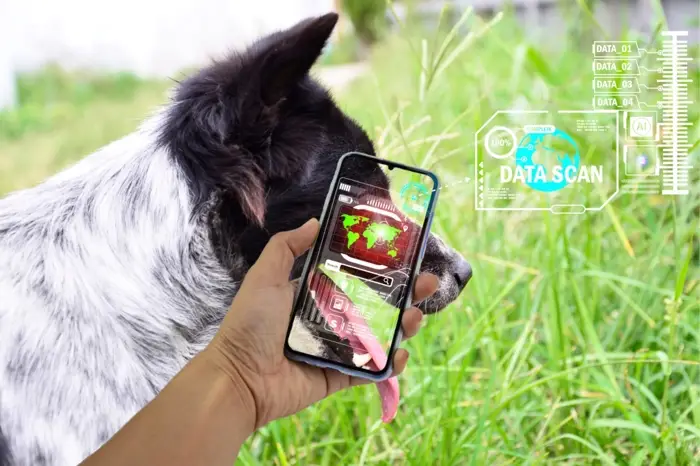Lost pets come home with Peeva.
The Search Plan: Effective Ways to Find Your Lost Dog Quickly
A decade lost, yet hope remained alive: this is the story of Luisa and her Cockapoo, Cleo. Their reunion, sparked by a microchip, defied time and distance, rekindling their unbreakable bond.
This heartwarming tale not only warms the heart but also underscores the profound impact of technology in reuniting pets with their families.
How to Find a Lost Dog?
When your dog goes missing, every second counts. Start by checking your immediate surroundings thoroughly; sometimes, dogs hide in the most unexpected places, especially if they are scared or injured. If this initial search doesn’t bring your dog back, it’s time to widen your net.
Spread the Word Fast
The power of community cannot be underestimated in these situations. Begin by informing your neighbours and asking them to check their yards and sheds. Dogs often don’t wander too far initially, unless startled. Utilise social media to its fullest – post in local groups, community pages, and any relevant online forums like Peeva’s lost pet database. Include a clear, recent photo of your dog, their name, where they were last seen, and your contact information.
Traditional methods like posting flyers around your neighbourhood are still incredibly effective. Make sure these flyers are visible, with a large photo of your dog, and mention any distinct features. Place them at eye level in high-traffic areas such as community boards, local stores, and street posts. Don’t forget to contact local animal shelters, rescue groups, and veterinary clinics. They can be invaluable resources as they are often the first place someone will bring a lost pet.
Preparing for a Structured Search
Once you’ve alerted your community, it’s time to organise a physical search. Gather a group of friends, family, or neighbours who are willing to help. A larger group can cover more ground, but make sure to coordinate effectively to avoid duplicating efforts.
Before heading out, prepare a search kit. This should include essentials like water, snacks, a flashlight (if searching at night), your dog’s favourite treats, and an item with your scent on it, like a worn piece of clothing. These items can be crucial in attracting your dog if they are nearby.
Also, consider the temperament of your dog. Are they adventurous or timid? Knowing their personality can help predict where they might go. Adventurous dogs might head towards parks or open spaces, while timid dogs might hide in quiet, enclosed areas.
Remember, your tone and body language during the search are important. Stay calm and use a friendly, familiar call or whistle. If your dog is nearby, a panicked tone might scare them further away.
How to Find Lost Dog: Strategic Searching

Time is of the essence, and a strategic approach can make all the difference. Mapping your search area is a crucial first step. Consider places your dog frequents or is drawn to – parks, trails, or friends’ homes. Also, factor in areas that might attract or scare them, like busy streets or quiet wooded areas. A scared dog may behave unpredictably, so expanding your search to less obvious places is key.
During the day, visibility is on your side. Search parties can split up to cover more ground. Communicate constantly, either through calls or messaging apps, to keep track of which areas have been searched. At night, things get trickier. Use flashlights not just to see, but to attract your dog’s attention. They might be drawn to the light or the familiar sound of your voice calling out.
Remember, dogs have a keen sense of smell. Leaving out an item with a familiar scent, like a bed or a piece of your clothing, at the spot they were last seen can help. Dogs often circle back to familiar scents, especially if they’re lost and confused.
Leveraging Technology in Your Search
Modern technology has revolutionised how we search for lost pets. Online platforms and alert systems can amplify your search exponentially. Websites and apps specifically designed for lost pets can broadcast your dog’s information to a wide audience quickly. Make sure to include clear photos, distinctive features, and your contact information.
Microchips can be lifesavers in these situations. If your dog is microchipped with a Peeva chip, for instance, any veterinary clinic or shelter that scans the chip can access your contact information, as long as your details are up-to-date in the database. This technology bridges the gap between lost pets and frantic owners, making reunions much more likely.
The Role of Community and Local Authorities
Communities often come together in amazing ways when a pet is lost. Reach out to local community leaders, schools, and churches to spread the word. Many communities have local “lost and found pet” groups on social media platforms where you can post your dog’s information.
Local authorities can also be a great resource. Informing the local animal control and police department about your lost dog helps widen the search. They are often the first to be notified about stray animals picked up in the area.
Keep updating these groups and authorities about any developments in your search. Persistence is key, and regular updates keep your lost dog in the forefront of their minds.
When to Stop Looking for a Lost Dog
This is perhaps the hardest decision a pet owner has to face. It’s important to understand that every situation is unique. Factors like the dog’s health, age, and the circumstances of their disappearance all play a role in this decision.
Some experts suggest a focused, intensive search for at least two weeks. However, there are numerous stories of dogs being found months or even years later. Balancing hope with practicality and emotional well-being is crucial.
During this challenging time, take care of your emotional health. Seeking support from friends, family, or online communities can provide comfort and encouragement. Remember, it’s okay to take breaks and ask for help. Keeping your spirits up is important not just for you, but for the effectiveness of your search.
How to Find a Missing Dog: Alternative Methods
Sometimes, traditional search methods need a little extra help. Hiring a professional pet detective or a tracking dog team can provide specialised skills and resources. These experts often have experience in tracking lost pets and can offer new strategies and insights. Another alternative approach is using scent articles. Dogs have an incredible sense of smell, and placing items with familiar scents in strategic locations can lure them out of hiding.
Psychological strategies also play a role. Setting up a “home base” near where your dog was last seen with familiar items and scents can provide a safe haven for them to return to. Regularly visiting and leaving fresh water and food can also encourage your dog to stay in the area.
Ensuring Future Safety
Once your dog is safely home, it’s time to take preventive measures to avoid future mishaps. Secure your yard and home to prevent escapes. Regular training, particularly recall commands, can also help prevent your dog from straying too far.
A crucial part of ensuring your pet’s future safety is through technology like microchips. Peeva’s microchips not only help in locating lost pets but also keep track of their medical records, which can be vital in emergencies. Ensuring your pet’s microchip information is up-to-date is as important as the microchip itself. Regular check-ups to ensure the microchip is working properly also offer peace of mind.
Conclusion
Losing your beloved dog can be a heart-wrenching experience, but remember, there’s always hope. With a combination of swift action, community support, strategic searching, and leveraging technology like Peeva’s microchips, you stand a good chance of being reunited with your furry friend. Stay positive, stay persistent, and don’t hesitate to reach out for help. Remember, your community is there for you, and technology like Peeva is revolutionising pet safety and reunification. Let’s keep our pets safe, one microchip at a time.
Peeva: Where Lost Pets Find Their Way Home
Transform your pet’s microchip into a lifeline. 24/7 phone support and lost pet alerts ensure your pet gets the help they need, when they need it.






